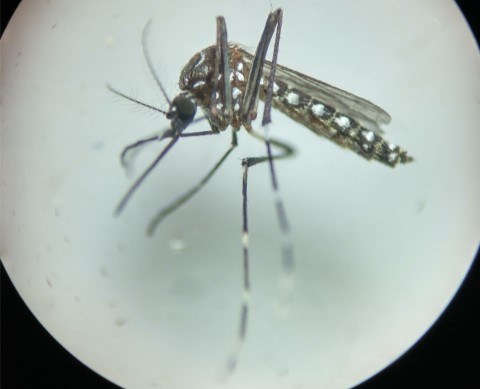
PALMDALE – Invasive Aedes mosquitoes, also known as the yellow fever mosquitoes, were detected in two new locations in Palmdale, authorities announced Thursday.
One sample was collected near Elizabeth Lake Road and Tierra Subida (10th Street West), and the other sample was collected near 35th Street East and Avenue R, according to the Antelope Valley Mosquito & Vector Control District.
The District had not detected this invasive mosquito in these locations prior to this identification, according to entomologist Karen Mellor.
Aedes aegypti — small black and white mosquitoes closely associated with human dwellings — was first discovered in the Antelope Valley in October of 2018. Unlike native Culex mosquitoes that generally bite during dusk and dawn, Aedes mosquitoes actively pursue people throughout the entire day and into the evening. Aedes mosquitoes feed almost exclusively on humans and tend to bite below the knees.
Aedes mosquitoes are known transmitters of diseases like yellow fever, dengue fever, chikungunya, and zika virus.
“Although these mosquitoes have the potential to carry these diseases, there is currently nothing to indicate that local transmission [is] occurring,” said District Manager Cei Kratz. “Keeping mosquito populations low remains of utmost importance due to the potential for these diseases to make their way into the mosquito population.”
Female Aedes mosquitoes lay eggs in small containers, such as vases, buckets, pots, and plant saucers, just above the waterline. The eggs dry up and
survive for six or more months, waiting for the container to re-flood so they can hatch. Aedes mosquitoes are typically introduced into new areas by bringing in containers from other areas that contain the eggs.
AVMVCD personnel have increased mosquito surveillance and will continue to place traps that are designed to attract egg-laying Aedes mosquitoes. Once trapped, the mosquitoes are contaminated with larvicide. When they leave the trap, they spread larvicide to several breeding sites around the trap. The adult mosquito also gets infected with a mosquito-specific fungus that kills her before she can spread diseases.
In addition to increased surveillance efforts, AVMVCD personnel are warning residents in the proximity of the invasive mosquitoes and advising residents on how to do their part to eliminate mosquitoes.
Residents can protect themselves from mosquito bites by following these recommendations:
- Wear EPA registered ingredients such as DEET, picaridin, oil of lemon eucalyptus, or IR3535 to exposed skin and/or clothing (as directed on the
product label). - Wear long-sleeve shirts, long pants, socks and shoes when mosquitoes are most active.
- Be sure window and door screens are in good repair to prevent mosquitoes from entering the home.
- Inspect yards for standing water sources and drain water that may have collected under potted plants, in bird baths, in discarded tires, etc.
- Check rain gutters and lawn drains to make sure they aren’t holding water and debris.
- Clean and scrub bird baths and pet watering dishes weekly.
- Check indoor plants that are kept in standing water for mosquito activity (i.e. Bamboo and Philodendron)
- Report daytime biting mosquitoes to the AVMVCD at 661-942-2917 or online at avmosquito.org/contact-us.
To stay up-to-date on mosquito-related information, visit www.avmosquito.org. For further questions or services, contact the Antelope Valley Mosquito & Vector Control District at 661-942-2917.
[Information via news release from the Antelope Valley Mosquito & Vector Control District.]
Previous related stories:
Invasive Aedes mosquitoes identified in 2 new locations in Palmdale
Invasive Aedes mosquito reappears in Lancaster and Palmdale
Additional samples of invasive Aedes mosquito found in Palmdale
–
Steven says
Heck. 2020 is doing a good job at ruining life.